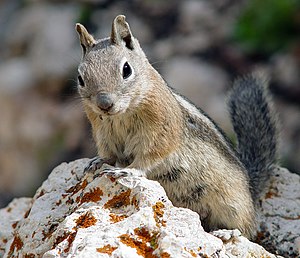Glires
| Glires | ||||||||||||
|---|---|---|---|---|---|---|---|---|---|---|---|---|

Golden-mantled ground burrow ( Spermophilus lateralis ) |
||||||||||||
| Systematics | ||||||||||||
|
||||||||||||
| Scientific name | ||||||||||||
| Glires | ||||||||||||
| Linnaeus , 1758 | ||||||||||||
| Orders | ||||||||||||
As glires (German also rodent ), a taxon denotes that the two orders of mammals rodents (Rodentia) and lagomorphs summarizes (Lagomorpha).
Originally the rodents were combined with the rabbit-like to a common order Glires. After this concept had been completely rejected in the meantime, there are recently again proponents of a theory that there is a close relationship between the two taxa. Due to the characteristics that can only be found in them, the monophyly of the hare-like is well founded today and the history of development, which has been separate for at least 70 million years, justifies the formation of its own order. Rodents and rabbits can be traced back to a common parent species due to common characteristics such as the incisor teeth , which is why they are grouped together as a Taxon Glires.
The rabbit-like are therefore the sister group of rodents with which they are united to form a common taxon (glires). Will be within the Euarchontoglires the euarchonta consisting of tree shrews (Scandentia), primates (Primates) and giant gliders (Dermoptera), compared:
| Euarchontoglires |
|
||||||||||||||||||||||||
|
|
literature
- W. Westheide and R. Rieger: Special Zoology. Part 2: vertebrates or skulls. Spektrum Akademischer Verlag, Munich 2004. ISBN 3-8274-0307-3